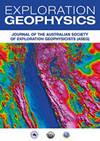复电阻率测量在韩国某浅成热液型金银矿床中的应用
IF 0.8
4区 地球科学
Q4 GEOCHEMISTRY & GEOPHYSICS
引用次数: 0
摘要
地下水和硫化物界面的电化学反应非常显著。与热液蚀变带和寄主岩石相比,矿化带中的硫化物相对丰富。复电阻率是一种用于可视化各种地下电化学反应之间差异的地球物理工具。Moisan山(韩国)的浅成热液Au–Ag矿化发生在广泛分布的黄铁矿带中,这是高级泥化和泥化蚀变带的典型特征。Moisan的浅成热液矿脉水平走向长度大于500 m,垂直走向长度约为300 m,受WNW断层带控制。在这种情况下,对矿床进行了试验台测试,以证明复电阻率测量在矿产勘探中的适用性。为了将复电阻率结果与超热液矿化的地质特征进行比较,我们在三维中可视化了复电阻调查结果和钻孔岩芯确认的Au–Ag矿化带。靶的石英脉表现出高电阻率和强相位响应;然而,蚀变带和寄主岩石都表现出比靶区更低的电阻率和较弱的相位响应。通过逐步聚类分析,生成了一张综合了两种地球物理模型的简单地图,以识别目标和背景之间的边界。地质调查和钻探调查表明,目标位于矿化带。复电阻率测量是探测浅成低温热液Au–Ag矿床的有用工具。本文章由计算机程序翻译,如有差异,请以英文原文为准。
Application of complex resistivity survey in an epithermal Au-Ag deposit, South Korea
Electrochemical reactions at the interface between groundwater and sulphides are remarkable. Sulphides in mineralised zones are relatively abundant compared to hydrothermal alteration zones and host rocks. Complex resistivity is a geophysical tool for visualising difference between various subsurface electrochemical reactions. The epithermal Au–Ag mineralisation at Moisan hill (South Korea) occurs in the extensively disseminated pyrite zone, a typical feature of advanced argillic and argillic alteration zones. The epithermal vein at Moisan had a strike length of >500 m horizontally and approximately 300 m vertically and was controlled by the WNW fault zone. In this context, the deposit was subjected to a test bed to demonstrate the applicability of the complex resistivity survey for mineral exploration. To compare complex resistivity results with geological characteristics of epithermal mineralisation, we visualised the complex resistivity survey results and Au–Ag mineralised zones confirmed by drilling cores in three dimensions. The quartz veins of the targets showed high resistivity and a strong phase response; however, both the alteration zones and host rocks showed lower resistivity and a weaker phase response than the target zones. Through a step-by-step clustering analysis, a simple map integrating both kinds of the geophysical models was generated, to identify the boundary between the target and background. Geologic survey and drilling investigations indicate that the target is well-localised in a mineralised zone. The complex resistivity survey is a useful tool for exploring epithermal Au–Ag deposits.
求助全文
通过发布文献求助,成功后即可免费获取论文全文。
去求助
来源期刊

Exploration Geophysics
地学-地球化学与地球物理
CiteScore
2.30
自引率
0.00%
发文量
33
审稿时长
>12 weeks
期刊介绍:
Exploration Geophysics is published on behalf of the Australian Society of Exploration Geophysicists (ASEG), Society of Exploration Geophysics of Japan (SEGJ), and Korean Society of Earth and Exploration Geophysicists (KSEG).
The journal presents significant case histories, advances in data interpretation, and theoretical developments resulting from original research in exploration and applied geophysics. Papers that may have implications for field practice in Australia, even if they report work from other continents, will be welcome. ´Exploration and applied geophysics´ will be interpreted broadly by the editors, so that geotechnical and environmental studies are by no means precluded.
Papers are expected to be of a high standard. Exploration Geophysics uses an international pool of reviewers drawn from industry and academic authorities as selected by the editorial panel.
The journal provides a common meeting ground for geophysicists active in either field studies or basic research.
 求助内容:
求助内容: 应助结果提醒方式:
应助结果提醒方式:


